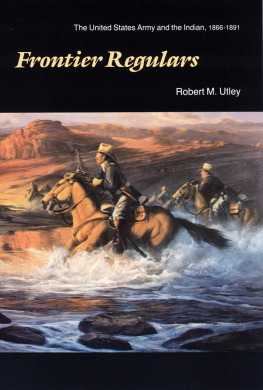Barakaldo Books 2020, all rights reserved. No part of this publication may be reproduced, stored in a retrieval system or transmitted by any means, electrical, mechanical or otherwise without the written permission of the copyright holder.
Publishers Note
Although in most cases we have retained the Authors original spelling and grammar to authentically reproduce the work of the Author and the original intent of such material, some additional notes and clarifications have been added for the modern readers benefit.
We have also made every effort to include all maps and illustrations of the original edition the limitations of formatting do not allow of including larger maps, we will upload as many of these maps as possible.
THE SOD-HOUSE FRONTIER
1854-1890
A Social History of the Northern Plains from the Creation of Kansas & Nebraska to the Admission of the Dakotas
BY
EVERETT DICK, Ph.D.
Professor of History in Union College, Lincoln, Nebraska
ILLUSTRATED
Table of Contents
Contents
Table of Contents
REQUEST FROM THE PUBLISHER
DEDICATED
TO THE MEMORY OF MY MOTHER AND TO MY FATHER WHO IN THEIR BRIDAL DAYS LEFT AN OLDER STATE AND SETTLED IN KANSAS DURING THE CLOSING YEARS OF THE SOD-HOUSE EPOCH
PREFACE
KINGS have had their annalists; military men and statesmen have had their biographers; the Frontier in American history has had its general historians. In few instances, however, has the common life of the people been portrayed. The present volume is an attempt to depict the life of the common man on the cutting edge of the frontier immediately following the date when it leaped across the Missouri River into Kansas and Nebraska and across the Red River into the vast domain now known as North and South Dakota. My purpose has been to relate the story of how the residents of the settled regions to the East left their old homes, journeyed to the new land, and conquered the obstacles incident to making new homes. The struggle was a heroic one and brings into view the dominant characteristics of the race.
The sources are largely newspapers, biographies and autobiographies, diaries, personal interviews, monographs, and material such as historical society collections and local histories.
I gratefully acknowledge the many courtesies and the help rendered by a host or people interested in the undertaking. Mrs. Clarence S. Paine, Secretary of the Mississippi Valley Historical Association, has given valuable suggestions as well as rendered every courtesy in her capacity as Librarian of the Nebraska State Historical Society. Dr. Addison E. Sheldon and his associates at the Nebraska State Historical Society have given assistance and encouragement in the research that made this volume possible, and I am especially indebted to Miss Martha Turner for her valuable aid in assembling illustrations. Mr. L. K. Fox, Secretary of the South Dakota Historical Society, likewise extended every courtesy in connection with my investigation at the South Dakota Historical Society Library. Mr. Kirke Mechem and his large staff at the Kansas State Historical Society rendered efficient and courteous service on the authors numerous visits there. Special thanks are due Professor Edward Everett Dale, President of the Mississippi Valley Historical Association, for his valuable suggestions and encouragement. To my honored major professor of university days, Professor Frederic Logan Paxson, I express not only gratitude for the stimulus for the research embodied herein, but also grateful appreciation for reading the manuscript and making valuable suggestions. Professor James Lee Sellers of the University of Nebraska has also given counsel and encouragement. To my wife, Opal Wheeler-Dick, are due words of appreciation for her faith in the project through years of research and for her valuable assistance in arranging the material and putting it in final form.
Nearly twenty years have passed since the SOD-HOUSE FRONTIER was written. The cordial reception which the public accorded this volume has been very gratifying. After three printings the supply was exhausted and the work has now been out of print for several years. Continued calls for the book, however, have led to the belief that another printing is desirable.
Only as they are familiar with the life of the common man who conquered this raw untamed area, can the present residents intelligently interpret the present. This printing is offered with the hope that on this one hundredth anniversary of the formation of Kansas and Nebraska, the SOD-HOUSE FRONTIER may be made available to the largest possible number of readers in order that our generation may better understand its cultural heritage.
Lincoln, Nebraska
May 7, 1954
EVERETT DICK
ILLUSTRATIONS
THE COUNCIL BLUFFS CROSSING ON THE OVERLAND TRAIL
THE MISSOURI AT KANSAS CITY IN THE FIFTIES
AN EMIGRANT NIGHT ENCAMPMENT ON THE PLAINS
TYPES OF PREEMPTION FRAUDS
A BOOM LITHOGRAPH OF SUMNER, KANSAS
THE CITY OF NEW BABYLON ON PAPER AND IN FACT
BREAKING THE PRAIRIE
WILDCAT CURRENCY
THE CHEESE CREEK RANCH
A SOD DUGOUT WITH ADJOINING SHED
THE PRIMITIVE AND THE ADVANCED IN SOD CONSTRUCTION
THE FIRST HOMESTEAD TAKEN IN THE UNITED STATES
LAND OFFICE BUSINESS
THE CHRISMAN SISTERS, HOMESTEADERS EXTRAORDINARY
FENCE CUTTING IN THE HOMESTEADER-CATTLEMAN WAR
SHOOTING BUFFALO ON THE LINE OF THE KANSAS PACIFIC
GRASSHOPPERS STOPPING A TRAIN ON THE UNION PACIFIC
FIGHTING A PRAIRIE FIRE
THE MAGAZINE TYPE OF HAY-BURNING STOVE
A SOD-HOUSE FAMILY
THE MARSH TYPE OF HARVESTER
A HORSE-POWER THRESHING MACHINE
MACHINES IN BONANZA FARMING
A CAMP-MEETING OF THE SEVENTIES
THE NORTHERN PACIFIC BUILDING WESTWARD OVER THE PLAINS
AN EMIGRANT CAMP OF THE EIGHTIES
MAIN STREET IN A KANSAS BOOM TOWN
A LIVERY STABLE OF THE EIGHTIES
A FRONTIER NEWSPAPER OFFICE
AN ITINERANT PHOTOGRAPHER
A FRONTIER WAGON AND BLACKSMITH SHOP
A PIONEER LEGISLATURE OF DAKOTA TERRITORY
THE SOD-HOUSE FRONTIER
INTRODUCTION
FROM THE TIME when the white man first stepped foot on the eastern coast of America, the course of settlement has been ever westward. By means of the decennial census maps the historian traces the steady advance of settlement and draws the frontier line a little farther to the west with each ten-year report until 1890, when the last land in the rain belt was removed from public to private ownership by land-office entry. Land hunger has been the principal motive for westward migration from the time when the early Virginians abandoned the idea of picking up jewels and gold from the ground and turned to the pursuits of husbandry. Although the frontier line moved westward by starts and jumps, its progress through the years was unremitting.











